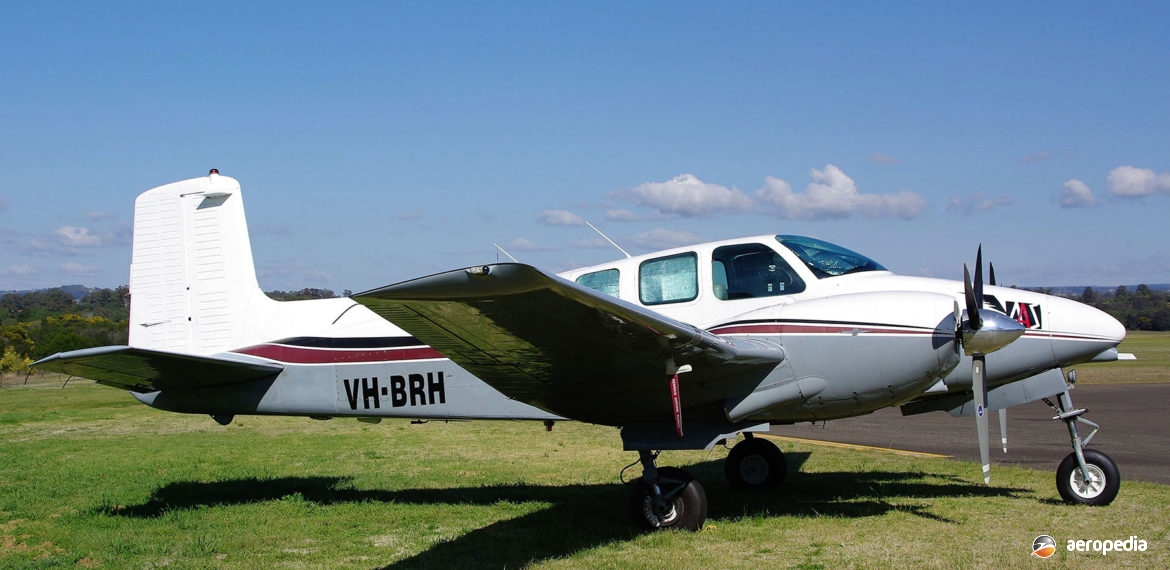Photograph:
Beech J-50 Twin Bonanza VH-BRH (c/n JH-163) at Camden, NSW in 2012 (David C Eyre)
Country of origin:
United States of America
Description:
Twin-engine light commercial transport
Power Plant:
Two 220 kw (295 hp) Lycoming GO-480-G2F6 six-cylinder horizontally-opposed air-cooled engines
Specifications:
- Wingspan: 14 m (45 ft 11⅜ in)
- Length: 9.61 m (31 ft 6½ in)
- Height: 3.51 m (11 ft 6½ in)
- Wing area: 25.83 m² (277 sq ft)
- Max speed at 3,660 m (12,000 ft): 378 km/h (235 mph)
- Cruising speed at 70% power at 4,630 m (15,200 ft): 359 km/h (223 mph)
- Stalling speed full flaps: 133 km/h (82 mph)
- Rate of climb at sea level: 387 m/min (1,270 ft/min)
- Service ceiling: 8,885 m (29,150 ft)
- Max range at 277 km/h (172 mph) with no reserves at 4,630 m (15,200 ft): 2,655 km (1,650 miles)
- Empty weight: 2,028 kg (4,470 lb)
- Loaded weight: 3,310 kg (7,300 lb)
History:
The Beech 50 Twin Bonanza was the first twin-engine, light commercial aircraft of post-war design to be produced in the United States. Over the years the type was developed through a number of models to meet customer requirements. Progressive changes involved up-rated engines and higher maximum take-off weights, as well as other refinements. Designed by a team led by Ralph Harmon, the Twin Bonanza was partly designed to meet a US Army requirement for a twin-engine aircraft capable of carrying six.
The prototype of the series, known as the Model 50, was flown for the first time on 15 November 1949, and production deliveries commenced a few months later in August the following year. This model was fitted with the geared 194 kw (260 hp) Lycoming GO-435 engine and had a max take-off weight of 2,495 kg (5,500 lb), some 66 examples of this model being completed.
Refinements led to the 1953 model being known as the A-50, and the similar 1954 model became known as the B-50. These were built during 1952 and 1953, and 139 were delivered, being basically the same but the gross weight having been increased to 2,722 kg (6,000 lb).
In 1955 the C-50 model was released with the 194 kw (260 hp) Lycoming GO-435-C2 engines replaced by 205 kw (275 hp) Lycoming GO-480-F6 engines. These were produced between 1954 and 1956, some 349 being delivered. The 1965 model D-50 was similar but this was fitted with 220 kw (295 hp) Lycoming GO-480-G2F6 engines, some 154 being delivered, and take-off weight having increased to 2,858 kg (6,300 lb).
Development continued with the D-50A, D-50B, D-50C and D-50E sub-variants, production of the D-50 series totalling 351 aircraft.
In 1957 the model E-50 had supercharged 253 kw (340 hp) GSO-480 engines and the take-off weight was 3,175 kg (7,000 lb); the 1958 G-50 had additional fuel capacity as an option and fuel-injected engines, being introduced in 1959; the H-50 in 1960 incorporated minor refinements over the G-50, having a gross weight of 3,311 kg (7,300 lb) and an airstair built in; and the J-50 in 1960 had more extensive cabin glazing, a re-designed nose, fuel-injected engines and seven seats. Production ceased in 1963.
In addition to the civil versions of the Twin Bonanza, 206 were supplied to the US Army between 1951 and 1960. These received the designations L-23A, L-23B, and L-23D, which became the U-8D in 1962, and were used extensively as the Seminole utility and liaison transport. The RU-8D variant was a battlefield reconnaissance model fitted with a Sideways Looking Airborne Radar unit (SLAR).
Total production of the Model 50 series was 974 aircraft, of which 768 were delivered to civil customers.
A number of Twin Bonanzas have appeared on the Australian Civil Aircraft Register over the years but only two remained registered in 2016. Several were used on commuter work, including D-50s VH-CLM (c/n DH53) and VH-CLN (c/n DH19); D-50A VH-CLO (c/n DH158); E-50s VH-CLP (c/n EH18) and VH-CLQ (c/n EH67), which were flown by Connellan Airways from Alice Springs, NT; VH-SKY (c/n DH197), a D-50A which was operated by Masling Airlines on routes in NSW; VH-CDE (c/n CH24), a B-50 with Skyways; VH-KPB (c/n GH114), a G-50G; and VH-UNB (c/n DH53), a D-50 which later became VH-CLM after service with Helicopter Utilities.
In 2020 VH-BRH (JH163), a J-50, survived at Camden, NSW but was not airworthy.

